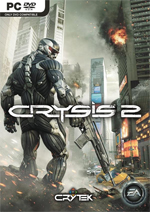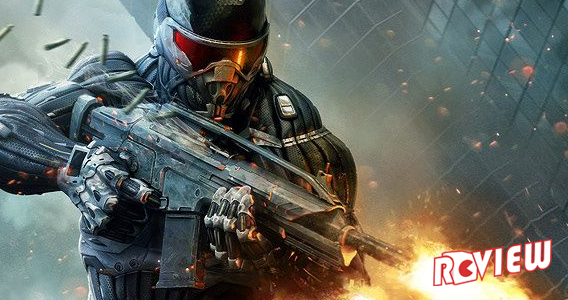 It’s not difficult to imagine EA sitting down with Crytek, somewhere in the indeterminate space between Crysis and Crysis 2, fingers tented carefully and asking “Can you make it more like Call of Duty?” I don’t mean “It’s a funny joke to think about,” I mean I believe this happened. I believe it occurred in our discrete reality.
It’s not difficult to imagine EA sitting down with Crytek, somewhere in the indeterminate space between Crysis and Crysis 2, fingers tented carefully and asking “Can you make it more like Call of Duty?” I don’t mean “It’s a funny joke to think about,” I mean I believe this happened. I believe it occurred in our discrete reality.
Indeed, I believe EA has this conversation with every developer to offer them product.
It’s easy to peer into the product and see the result of this conversation (which I will now portray as a factual historic event); fibers of Call of Duty have been infused in the deep tissue of Crysis, coloring its fundamental layers, its skeleton.
Amazing, then, that it remains, unquestionably, its own game.
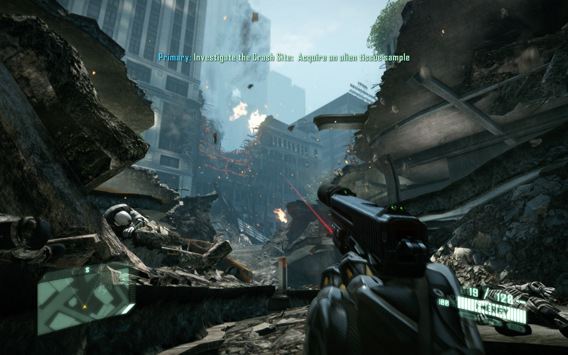
Crysis 2 is very much a different animal from its predecessor. It feels different, it looks different, and it plays different. By comparison, Crysis feels more like a tech demo—a staggering, brutal tech demo, unrelentingly demoing the most wizard tech one could imagine—where Crysis 2 feels like the retail product it was ultimately designed to describe.
In many ways, the difference is such that Crysis 2 might be described as a less impressive game than the original, but also a better game. This is an important distinction.
The graphic engine is a prime example. As fans have no doubt seen in numerous unforgiving comparisons scattered across the internets, the texture work of Crysis 2 is often not the equal of Crysis. Yes, compromises have been made for the transition to consoles—but the concessions are careful and well chosen.
As a result, Crysis 2 rarely appears visually inferior to its predecessor, and it runs with infinitely superior efficiency. I found that (on my hardware) Crysis 2 on maximum settings ran with a significantly higher framerate than the original on lesser settings, while being visually superior to those lesser settings.
Yes, regardless of compromises made for the console market, the number of games that look better than Crysis 2 can be counted on one hand, and the number that look better and perform better is even fewer, perhaps none. However, it is only fair to note that this will be little comfort to PC players with monstrous gaming rigs; such compromises gain them nothing.
On that note, there are a few asterisks the dedicated PC gamer may wish to take note of.
First and foremost is the absence of advanced graphics options. The game provides three pre-set options with no ability to fine tune settings for optimum performance. Though the advanced gamer will no doubt fiddle with configuration files to solve this problem, the omission may hurt some middle of the road customers who want to squeeze every last possible frame out of the game.
Additionally, DirectX 11 is not currently supported (though Crytek has announced a future patch to rectify this), and there are some other design decisions that may irk PC players (for example, multiple keys cannot be bound to the same function). These items will be incidental to the average gamer, but hardcore PC disciples may find them of greater concern.
Diving into the campaign experience, it’s clear that Crysis has changed. Most immediately, players will notice the smaller, contained environments, as compared to the sprawling jungle of the previous entries.
The approach, however, is clever. Crysis was absolutely a more open game, but it was rarely open in a useful way. There was typically a great deal of empty jungle, sprinkled with pockets containing small villages, shacks, vehicles, and the other elements of basic shooter design.
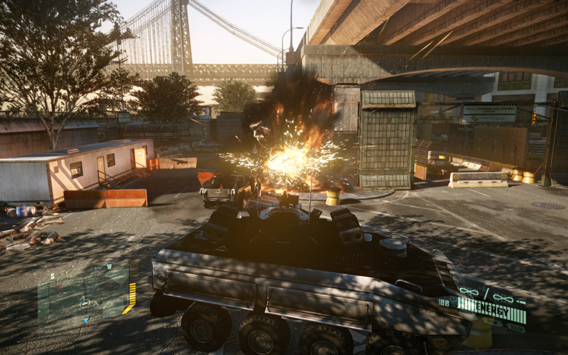
Crysis 2 trims the fat, instead seeing the nano-enhanced protagonist battling within a ruined New York city, which is represented largely by a series of moderately sized sandboxes, strung together to form missions.
These sandboxes are of a very comfortable size, open enough that there are always numerous ways to play and paths to explore. Verticality can play an interesting role, sometimes allowing the player to scale buildings or massive blown-out craters for a tactical advantage.
While some may resent the smaller environments, they feel as if they contain more, and are better designed to be leveraged by the player. Opportunities for tactically repositioning and utilizing the environment are everywhere, creating battles that are distinctly more satisfying than similar situations in Crysis. Simply put, the jungle is pretty empty, and New York is not. The effect on gameplay is clear.
The nanosuit has also seen some careful refinement. Most notably, the speed and strength abilities of the suit (in the original Crysis, distinct modes that had to be activated at the expense of all others) have been rolled into the base functions. Now called “power mode,” speed and strength functions activate automatically when appropriate; such as when the player sprints or holds down the jump button for a power jump.
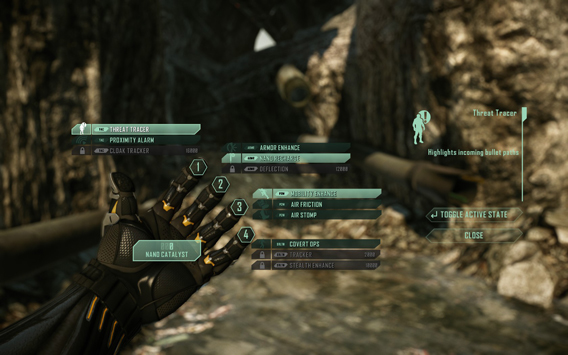
This works out as a significant improvement, massively increasing the usefulness of these powers. Player mobility is significantly increased, as the player can now quickly—and without thinking—trigger mobility powers that were previously far more inconvenient.
The one drawback to this system is the reduced role of speed powers. Where speed mode in Crysis was literal super-speed, the only speed function in Crysis 2 is the sprint—which operates at a distinctly lower speed. I immediately missed the ability to employ super-speed (alongside a trusty shotgun) in enemy assaults.
Fortunately, the suit has also seen a number of expansions. New to the franchise is a currency-based upgrade system, where “nano-catalyst” is collected from fallen aliens and employed in the evolution of the nanosuit with a number of swappable perks.
These can range from the expected stealth and armour upgrades to more unique offerings, such as the threat tracer (which highlights the paths of enemy fire). Perks fall into four sets, and one perk from each set can be activated at any time, allowing the nanosuit to be tailored to specific encounters and play-styles. It’s a fun system to play with, though it should be noted that some of the more expensive upgrades somewhat reduce the usefulness of earlier perks.
Additionally, the single-player mode employs a new cover system that comfortably allows the player to enter and utilize cover without becoming sticky. This is a useful way to recharge suit energy without having to hide and break the flow of the battle.
Also new is a way-finding system that highlights alternate routes and useful environmental elements. This is great in the early missions for players who need to be trained to recognize the gameplay opportunities Crysis affords. Though it feels almost like cheating in the later missions (with prompts as overt as “Hey, snipe dudes over here,”) the HUD never quite highlights all the options, always allowing for a level of exploration.
The campaign rolls out slowly at first, and though some may argue that the pacing lacks, I found these early chapters encouraged exploration that, in the more bombastic later chapters, might have been impractical. It’s a long introduction, certainly too long, but not cripplingly so.
Around the half way mark, matters pick up considerably and the campaign comes into its own. Large battles are fought in well-sized, wonderfully designed arenas that cater directly to the super-powered nanosuit, while powerful weapons are freely available, and dangerous enemies are everywhere.
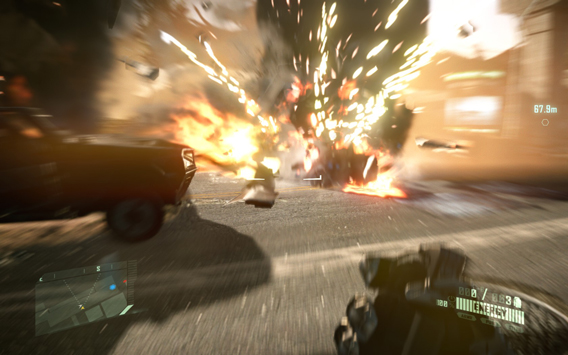
This is where Crysis 2 excels. Every battle can play out differently if the player chooses to pursue different options. Some encounters can be bypassed entirely with a carefully chosen path and the application of stealth, while it is equally possible to switch on armor mode, commandeer a heavy weapon and go commando.
There’s a synergy between player powers and level design that makes combat inherently satisfying. Objects that are heavy enough to do damage can be power kicked into enemies (and turned into deadly bombs with the clever application of C4), the player can slide under obstacles or down inclines, and there’s always somewhere to climb and escape to in a dangerous situation. Everything is shaped carefully to suit the hit-and-run nature of the nanosuit and its suite of abilities.
The pacing problem, however, returns in the games closing moments. The campaign ends on an encounter that is hardly different from any other battle in the game; there’s no boss to speak of, and though the enemies are unique to that encounter, they are neither challenging nor interesting to fight.
Thus, the game ends on a placid, unfortunate note that doesn’t particularly satisfy.
The story is similarly plagued; neither compelling nor well told, it’s a mess of half-missing exposition, jargon, irrelevant characters, and half-baked ideas. It’s unfortunate, because a sharp science fiction story could have easily elevated the core game.
Some interesting ideas do appear; the dialogue drops occasional hints about the ongoing creation of the new protagonist, and the mysterious, unknown nature of the nanosuit is intriguing—but sadly these elements are not sufficient to surmount the critically underdeveloped narrative.
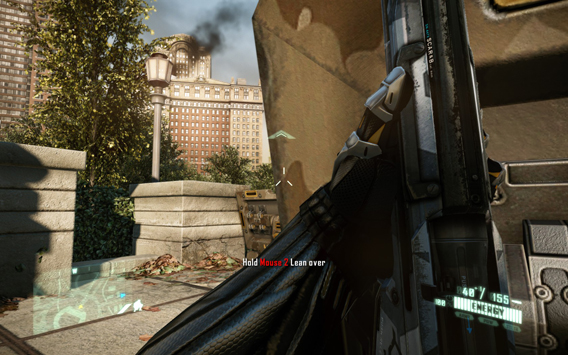
Of course, the campaign is not all there is to be had—EA’s Call of Duty conversation had to yield fruit, and so it does in the multiplayer.
At first glance, this multiplayer component is a Call of Duty game. Honestly, the developers weren’t even subtle about it, with several items in the perk system lifted directly from that series. Players create custom classes by selecting weapon loadouts and attachments, alongside nanosuit modules (the aforementioned perks).
Once a match begins, however, it’s clear this is not a game that works out much like Call of Duty. Indeed, how could it with a team of nano-enhanced supermen on the field?
The learning curve is steep and brutal; the powers of the nanosuit inform every moment of competitive play. Clever players can use stealth or mobility powers to suddenly vanish from a combat scenario, only to reappear at a flank to destroy the enemy.
It’s worth noting, however, that the game is not as meticulously balanced as some other products on the market. Some weapons and tactics have distinct advantages (cloaking snipers will decimate entire enemy teams) that can be difficult to surmount, but the imbalance is not so severe that it becomes problematic. Clever use of nanosuit powers can secure victory.
I found the multiplayer dialogue to be something of a departure from the game’s otherwise solid voice work; the multiplayer characters bark oafish dialogue with obnoxious voices, sounding more like a party of drunken bros than elite post-human super-soldiers. I hear enough bros on the mic, I don’t need the game’s assistance for that.
In any case, despite a clear attempt to Call-of-Duterize the multiplayer component, Crysis 2 offfers a mechanic that is fresh enough and new enough to surpass mere imitation. Though the campaign is the purest representation of what the game offers, the multiplayer is a significant success and will keep gamers playing long after the ten hour single-player campaign is done with.
Crysis 2 is largely a refined, improved experience. Though it doesn’t push the same boundaries as the original, a careful eye has been taken to determine what serves the player and what doesn’t, and the result is a tighter game that’s more fun to play, even if it isn’t quite as impressive.
Crytek
Publisher
Electronic Arts
System
PlayStation 3, Xbox 360, PC (PC Reviewed)
Modes
Singleplayer, online multiplayer
Release Date
March 22, 2011
*A copy of this title was purchased by Gamesugar for review
